 About me
About me Creative
Creative Humor
Humor Writings
Writings Links
Links Contact me
Contact me
|
|||||


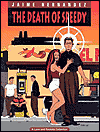 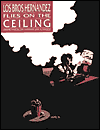 Jaime Hernandez and his brothers have been publishing their comic magazine Love and Rockets since 1982. Jaime's comic, Locas, started out as a science fiction romance/adventure comic, but it quickly left the fantasy elements behind and turned into a very human and realistic story about a circle of friends in a suburb to L.A, with only minor weird elements returning now and then. I have seldom encountered a comic book character who seems as real as Maggie, the protagonist in most of the stories. My favorite episodes are the ones in the long, soap-operatic book The Death of Speedy (published in Swedish under the títle Speedy Ortiz' död), and the shorter stories in the more experimental Flies on the Ceiling. After that, the characters seem to either get into weird situations that I can't identify with, and/or become passive and disillusioned. In October 2004, all Locas stories were collected into one huge 780 page hardcover book. 
Uzumaki Horror comics are almost universally bland. Japanese comic art is often cheaply produced mass-market fluff with stereotypical big-eyed characters. Apparently, no-one told Junji Ito this, because he went ahead and wrote and drew a horror comic that's actually really creepy. What's more, it has relatively realistic art, reminiscent of Moebius's style, with careful attention paid to compositions and textures. The story itself concerns a Japanese town where strange things start happening. And the events are not so much connected to a place or a person as to a shape: the spiral. There are things to criticize, such as lacking character development, and the often loose connection between chapters, but on the whole it's the best horror comic I've seen. The comic was made into a vastly inferior movie in 2000. 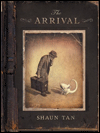 Shaun Tan's wordless, sepia-toned story of an immigrant into a new and unfamiliar country.  Amy and Jordan Mark writes strange, hilariously negative comic strips about Amy and Jordan, and draws them in a geometrical, naivistic style. Everything goes wrong for the main characters, often in strange and morbid ways. Example dialogue: "Bird watching is a fascinating hobby. Wait a second! Those aren't birds! They're monstrously deformed creatures of uncertain origin!" Mark Beyer has written three different books called Amy and Jordan, which is somewhat confusing. Look for the one published by Pantheon (2004), and also for his book Dead Stories. 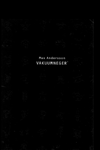
Vakuumneger Max Andersson, obviously inspired by Mark Beyer, has written a number of dark and bizarre comics, many of which I like better than anything Beyer has done. Unfortunately, I usually prefer his older comics, which have looser, less rigid drawings. Vakuumneger is the Swedish collection of his first short stories, of which I like Portkoden, Vakuumneger, Containrar, Störningsjouren 1 & 2 and Jultomten kommer. I believe that some of these comics have been reprinted in American anthologies like Zero Zero and Snarf. In Sweden, Andersson is most famous for his brilliant milk carton parody images. In the US, he's probably most well-known for his book Pixy. He also writes and draws a comic book called Death & Candy. 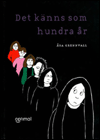
Det känns som hundra år Åsa Grennvalls första seriealbum och det av hennes album jag gillar bäst, trots att, eller möjligtvis just för att, hon i det så konsekvent beskriver sig själv som ett plågat offer omgiven av stereotypt idiotiska föräldrar och lärare. Bitvis hysteriskt roligt. |
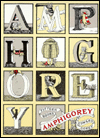
Amphigorey While not strictly comics, Edward Gorey wrote delightful little picture books, often involving Lewis Carroll-style nonsense verse about children who die tragically in Victorian settings. Amphigorey collects many of his best works, including The Doubtful Guest - in which a penguin-like creature invades and confuses a Victorian home, The Curious Sofa - the world's most subtle pornographic work, and The Insect God, about an abducted child. 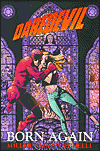 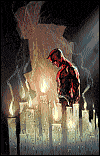 Daredevil The blind superhero Daredevil was invented by Stan Lee in 1964. Daredevil was basically a second-rate Spider-Man clone, and the Daredevil comic book was consistently awful until issue #168, in 1980, when Marvel let a young Frank Miller take over the writing and art. Miller was more interested in film noir and ninjas than superheroes, and inspired by comics legend Will Eisner, he quickly re-fashioned Daredevil into a dark crime comic with a liberal sprinkling of ninjas. Improbably, Teenage Mutant Ninja Turtles actually started as a parody of Miller's ninja stories. Miller's early comics were still pretty juvenile, but with a certain stylishness about it, and his storytelling experiments and exceptional ability to create long, wordless sequences, using the size and shape of the panels to create a rhythm, made Daredevil the most interesting superhero comic around at the time. His best issues were #179 and #181 - the first one told from a reporter's viewpoint, the other from Daredevil's enemy Bullseye's.
Shortly after that, Miller left the series, only to return for a few issues that topped anything he'd done before. Those issues, illustrated by the amazing David Mazzucchelli, were later collected into a paperback under the name Daredevil:Born Again. From a storytelling standpoint, Born Again is really extraordinary, using many parallel storylines in a way that's both very effective and that would be impossible to repeat in another medium.
Then again, however accomplished it may be technically, it's still a comic about a blind man who dresses up in a red devil costume, jumps from rooftop to rooftop, and fights an improbable sumo wrestlerish gangster boss. Why the heck were the best writer and artist in the business creating that kind of stories? Because the American comic market was - and is - in terrible shape, and for historical reasons, including a distribution system that almost only reaches superhero fans, superheroes are what you have to create if you want to make a living as a comics creator in the US. For example, two of the smartest, most well-written comics in recent years are Alias and Ex Machina. The first one is about a private detective; the other one is a political thriller about the mayor of New York. And the main characters in both comics just happen to be ex-superheroes, because without a superhero angle, the books wouldn't sell at all. Now, I've grown up with superhero comics, so I'm pretty accepting of the oddities of the genre, but still, I find it absurd that many of the most sophisticated comics around are based on forty-year old children's entertainment. Anyway - the last few years, Daredevil has been written by Alias writer Brian Michael Bendis, and if what you want to read is an intelligent, realistic comic about a blind man who dresses up in a red devil costume, jumps from rooftop to rooftop, and fights an improbable sumo wrestlerish gangster boss, you're in luck. Click the "Bendis" art links above to see examples from various recent trade paperbacks. Oh, and there was a Daredevil movie, starring Ben Affleck. In case you're not very good at English, "starring Ben Affleck" means roughly "keep away from the movie, and if it approaches you, hit it with a stick!". The comics are so much better than the movie that it's not even funny. 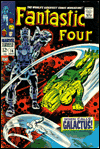 Fantastic Four, issues #45-87 These superhero comic issues from the late 60's featured over-the-top, melodramatic dialogue, and lots of evil megalomaniacs with hypno-rays and killer robots. They also had much charm and style, each issue brimming with imagination and memorable characters. Jack Kirby's stylized, dynamic art brought a sense of three-dimensionality to the world, and he had an incredible sense for design. If evil robots, cosmic beings and anti-matter universes sound like your kind of thing, try issues #45-87 of Fantastic Four. 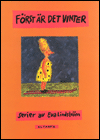 Först är det vinter Eva Lindström är en i mitt tycke underskattad serietecknare inom genren absurd humor. De flesta serierna i albumet - ingen serie är längre än två sidor - lämnar mig visserligen oberörd, men några få - Lundin på ordermottagningen, Mitt förslag, Dom flyttar städerna, och framför allt Annsofis nya roll är helt briljanta och gör albumet väl värt att köpa. |
|
|||